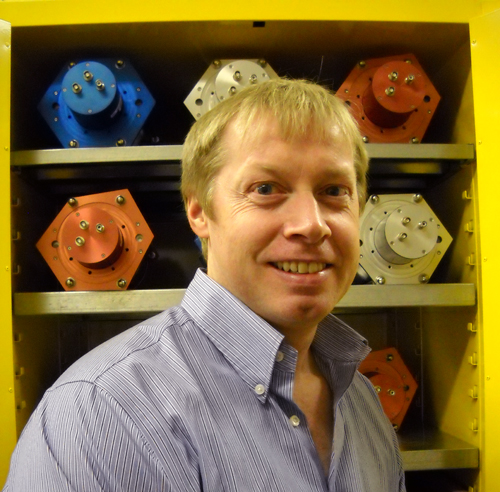
New insights into where matter came from – and ideas for building cheaper but safer nuclear power plants for an energy-hungry world – might result from a new U of G-led project to install the largest device of its kind in a Canadian laboratory.
In this $1.8-million project, physicist Paul Garrett will lead assembly of the instrument at a subatomic physics laboratory in Vancouver.
Using the planned array of neutron detectors to track atomic particles, he says, scientists hope to probe nuclear structures, yield insights about processes that made many of the elements in the universe, and even help improve nuclear reactor designs and waste storage.
It will likely be fall 2012 before the device begins running. But this fall, Garrett is conducting critical tests of the instrument’s components in his MacNaughton Building lab. As leader of the DESCANT (Deuterated Scintillator Array for Neutron Tagging) project, he needs to ensure that the neutron detector units are in perfect working order for their exacting task.
He’s now testing all 70 units in his basement lab; he says other arrays at American and European labs for detecting neutrons or gamma rays contain far fewer detector units. The first detectors arrived in July and Garrett expects to complete testing by the end of this semester. He’s receiving batches of the units from their Ohio manufacturer and sending the approved detectors to the TRIUMF laboratory for subatomic physics in British Columbia.
Says Aaron Liblong, a fourth-year undergrad in nanoscience, working on the project since the summer: “We’re making sure the detectors work as they’re supposed to.”
About the size and shape of a backyard pool pump, each unit weighs about 7 ½ kilograms. Assembled into an array, the detectors will be used with radioactive beams produced by the TRIUMF accelerator.
The new instrument will detect collisions between neutrons and deuterium, or “heavy” hydrogen, in the detectors. That will allow scientists to study nuclear decay rates and emission of neutrons.
Similar processes are believed to have produced most of the chemical elements heavier than iron that make up matter. Garrett says these studies might help us learn more about these processes, which are likely still occurring in such events as supernova explosions or collisions of neutron stars.
He adds that DESCANT studies will also help the nuclear industry. Scientists can use data from the instrument to calculate how quickly reactor waste will decay and how much radiation will be emitted after spent fuel is removed from a reactor.
Currently all nuclear waste is stored in temporary facilities. Information from DESCANT might help make long-term storage and transport more cost-effective.
“These experiments are interesting for academic nuclear physicists but also have a strong applied focus. Anything we do to give engineers a better understanding of decay heat profile will lead to safer handling of spent nuclear fuel and wastes.”
Garrett will help lead construction of DESCANT during a research leave beginning in January.
The project has been funded mostly by the Canada Foundation for Innovation and the Ontario Research Fund, with contributions from TRIUMF.
At TRIUMF, studies of neutrons with this new instrument will complement research using a gamma-ray detector also being built in Vancouver by a team led by U of G physicist Carl Svensson.
At Guelph, Garrett is teaching a graduate course in nuclear reactions. This past summer, he chaired an international symposium of about 140 scientists who met in Guelph to discuss nuclear physics and related topics. It was the first time this gathering has been held in Canada.